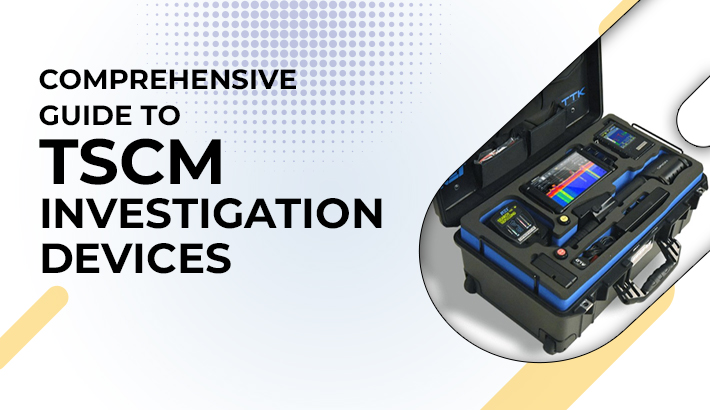Introduction:
In a world where information is a valuable commodity, the threat of electronic surveillance looms large, particularly in high-tech cities and sensitive environments. Technical Surveillance Counter-Measures (TSCM) investigations are instrumental in detecting and neutralizing electronic eavesdropping devices. This comprehensive guide explores an extensive list of TSCM investigation devices, each designed to ensure the security and confidentiality of sensitive information.
- RF Spectrum Analyzers:
- At the forefront of TSCM investigations, RF spectrum analyzers are essential tools for detecting and analyzing radio frequency signals. These devices help identify unauthorized transmitters, communication devices, and other RF-emitting devices that may compromise security.
- Non-Linear Junction Detectors (NLJD):
- NLJDs play a crucial role in TSCM investigations by detecting the presence of semiconductor components. This includes transistors commonly found in electronic devices such as microphones, cameras, and other eavesdropping equipment.
- Wideband Receivers:
- Capable of capturing a broad range of frequencies, wideband receivers are indispensable for TSCM professionals. They help identify covert listening devices, wireless transmitters, and other unauthorized communication devices operating within a wide spectrum.
- Frequency Counters:
- Frequency counters are essential tools for measuring the frequency of radio signals. TSCM experts use them to identify the presence of unauthorized transmissions and maintain a vigilant watch on the frequency spectrum.
- Time Domain Reflectometers (TDR):
- TDR devices are employed in TSCM investigations to detect and locate hidden wiring. By identifying conductive cables commonly used in covert listening devices, TDRs contribute to comprehensive bug sweeping.
- Infrared (IR) Viewers:
- In the realm of optical surveillance, IR viewers are utilized to detect infrared signals. This aids in the identification of IR-based surveillance devices, including cameras, which may operate in a covert manner.
- Acoustic Noise Generators:
- As a countermeasure against audio surveillance devices, acoustic noise generators are used to create background noise. This technique helps mask conversations and confound audio surveillance equipment.
- Wireless Camera Detectors:
- Designed specifically to detect radio frequency transmissions from wireless cameras, these detectors are crucial for uncovering hidden video surveillance devices. TSCM professionals employ them to ensure the security of sensitive areas.
- Telephone Line Analyzers:
- TSCM investigations often involve the examination of telephone lines for anomalies. Telephone line analyzers identify irregularities that may indicate the presence of wiretaps or other eavesdropping devices compromising telecommunications security.
- Audio Spectrum Analyzers:
- Audio spectrum analyzers are used to analyze audio signals comprehensively. TSCM experts employ them to identify anomalies or unauthorized transmissions within the audible frequency range, ensuring a thorough examination of potential threats.
- Hidden Camera Detectors:
- Utilizing infrared or radio frequency detection, hidden camera detectors are vital for TSCM investigations aimed at locating covert video surveillance devices. These devices play a key role in ensuring privacy and security in various environments.
- GPS Signal Detectors:
- With the prevalence of GPS tracking devices, GPS signal detectors have become essential in TSCM investigations. They identify the signals emitted by GPS trackers, contributing to the protection of sensitive locations and assets.
- Ultrasonic Listening Devices:
- Ultrasonic listening devices operate at frequencies beyond the range of human hearing. TSCM investigations leverage ultrasonic detectors to identify and neutralize these covert listening devices.
- Optical Viewers:
- Optical viewers are employed in TSCM investigations to examine optical signals. They help detect laser-based surveillance devices or optical transmitters that may be used for covert observation.
- Wireless Network Analyzers:
- TSCM experts utilize wireless network analyzers to analyze Wi-Fi and other wireless networks comprehensively. This assists in identifying unauthorized devices or potential vulnerabilities in the wireless infrastructure.
- Phone Tap Detectors:
- Phone tap detectors play a critical role in TSCM investigations focused on telecommunications security. These devices identify the presence of phone taps or other wiretapping devices on telephone lines.
- Digital Forensics Tools:
- In the digital age, TSCM investigations extend to digital forensics tools. These tools, both hardware and software-based, analyze digital devices for signs of electronic surveillance, malware, or unauthorized access.
- TEMPEST Equipment:
- Developed to protect electronic equipment from eavesdropping emanations, TEMPEST (Telecommunications Electronics Materials Protected from Emanating Spurious Transmissions) equipment ensures that electronic emissions do not compromise sensitive information.
- Portable X-ray Systems:
- TSCM investigations often involve the inspection of electronic devices for hidden components or modifications. Portable X-ray systems aid in revealing the internal structure of devices without physical disassembly.
- Faraday Bags:
- Faraday bags are indispensable for shielding electronic devices from external signals. They create a protective barrier that prevents remote tampering or communication, ensuring the security of sensitive electronic equipment.
Conclusion:
In the ever-evolving landscape of electronic threats, TSCM investigations stand as a crucial line of defense. The extensive list of TSCM investigation devices outlined here reflects the complexity and diversity of the tools required to ensure the security of high-tech cities and sensitive environments. As technology continues to advance, TSCM professionals will leverage these devices and innovate new solutions to counter emerging threats, safeguarding against electronic espionage and preserving the integrity of sensitive information in the digital age.


